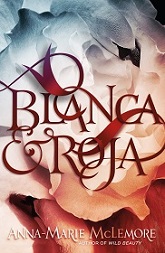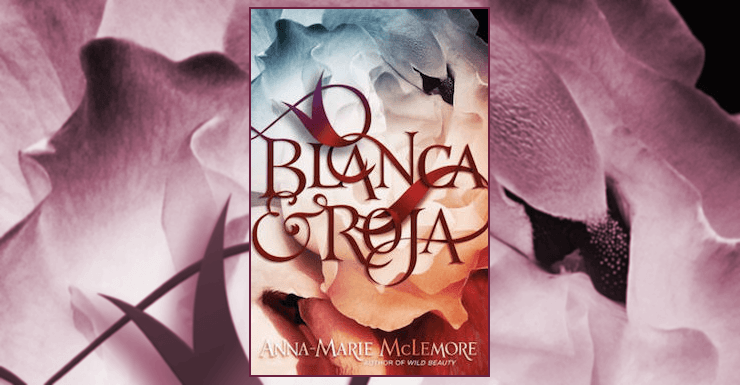Blanca & Roja is as haunting and beautiful as a frost-tinged forest at dusk. It is a poem stretched into prose then stitched around ancient fairy tales like a grandmother’s quilt. It is astonishing. Defiant. Wondrous. Cutting. Feverish. Dazzling. It is all of those things and so much more.
The del Cisne sisters, Blanca and Roja, could not be more different. Blanca is soft and pretty, a delicate flower with blonde hair and light golden skin. Roja is rough around the edges, her ruddy brown skin and blood-colored hair marking her as trouble. In every generation, there are always two girls born, one who grows up a woman and one who is turned into a swan. For most, this competition would turn sisters into enemies. Blanca’s mother tries to make her gentle and graceful so as to impress the swans so much they leave her be, while Roja’s father tries to make her tough and strong to prove to the swans she deserves her humanity. However, the girls blend themselves together, wearing each others’ clothes and perfume and holding each other so tight that in the dark even their family mistakes one for the other.
One day the swans arrive, but so too do a cygnet swan and a yearling bear. The yearling and the cygnet shed their animal forms and become the lost boys they once were. The woods called to rich boy Barclay Holt, now known as Yearling, after a terrible event left him broken and bleeding on the forest floor, and he became a bear. Page, the nonbinary trans son of apple farmers, was taken by the woods as well. Although the boys turn human again, their stories have only just begun. Page hides from the family she thinks doesn’t love her, and Yearling from the people who nearly killed him. As romance blooms between the quartet, fractures form between the sisters. The swans control the game board, but Blanca and Roja are determined to play by their own rules … even if it means lying to each other and keeping secrets.
If I told you Blanca & Roja was a retelling of “Snow White,” “Rose Red,” and “Swan Lake,” it would be the truth, but an incomplete one. Yes, it soaks classic fairy tales in Latinx mythology and Spanish vocabulary, but that is a shallow summation. It’s the kind of story that makes you realize you’ve been using the descriptor “magical realism” all wrong; that it is more than just magical elements seeping into the real world but subversion and surrealism colliding with and exposing the everyday.
McLemore’s use of magical realism is what makes this whole story work. It gives the novel the sheen of the in between. Not quite fantasy but not quite traditional literature. Fairy tale and reality, fact and fiction, magic and mundane. The stories of why the swans take a girl are as varied as the girls they take. That very question—“Why?”—is never even asked. Which story is real and which are fake doesn’t matter; knowing why won’t stop the swans. They come. They take. They leave. Just like the woods chose to take Yearling and Page. The boys don’t know how or why, only that the woods decided it was time. Magical realism grounds the more fantastical elements while simultaneously enhancing the practical to the mythic.
Buy the Book


Blanca & Roja
Stories help us understand our world, but they also establish expectations. The princess is offered the world on a silver platter. The girl with sharp teeth and harsh words must be a fearsome witch. Fairy tales are about brave princes, not peasant boys with she/her pronouns. All four stumble on bits and pieces of familiar fairy tales, but the morals of those stories don’t seem to apply to the teens way they do fictional characters. The truths carved out of myths and legends don’t hold up in a world where people aren’t light or dark, good or bad, right or wrong. Page and Yearling, Blanca and Roja must forge new lessons on old stories. Attaining that awareness, however, is easier said than done.
Blanca & Roja is in part about managing expectations, but also about defying them. Their whole lives, people have been telling them who they are and what they’ll become. Yearling doesn’t yet see that he can want more than the cold, cruel life his family offers, just as Page has yet to learn that being misunderstood isn’t the same as being rejected. Everyone assumes the swans will chose Roja because everyone has decided she is worth less than Blanca. The four teens have not yet discovered that no matter what box society tries to put you in, you can always refuse.
I have to admit, writing this review took me longer than most. Blanca and Roja and Page and Yearling are hard creatures to pin down. Their stories are easy to understand and their actions clear and precise, but whenever I tried to consolidate them into critique form, they slipped through my fingers like glitter or feathers. I knew how I felt about them, the shape of their experiences, the weight of their lives on mine, but turning that those thoughts into words, dragging the abstract into concrete, seemed particularly daunting.
Perhaps the stress and verbal violence of last few weeks caught up with me. The world shifted on its axis between the time I began drafting this review and when I submitted it, and will have changed again by the time it goes live. I have my own story to tell, but those who would force their interpretation of who and what I am—and of what I am allowed to be—well, sometimes they win. Yearling is right when he tells Page the world should accept us all for who we are and fuck those who stand in our way. But Page is also right when she replies that the world won’t always bend to your will and that sometimes it’s more important to make your own family. Those in charge will not respect you for resisting their arbitrary yet callous set of rules, but you can die fighting, live loving, or be like Blanca and Roja and do both.
Blanca & Roja is available from Feiwel & Friends.
Alex Brown is a YA librarian by day, local historian by night, pop culture critic/reviewer by passion, and an ace/aro Black woman all the time. Keep up with her every move on Twitter, check out her endless barrage of cute rat pics on Instagram, or follow along with her reading adventures on her blog.










